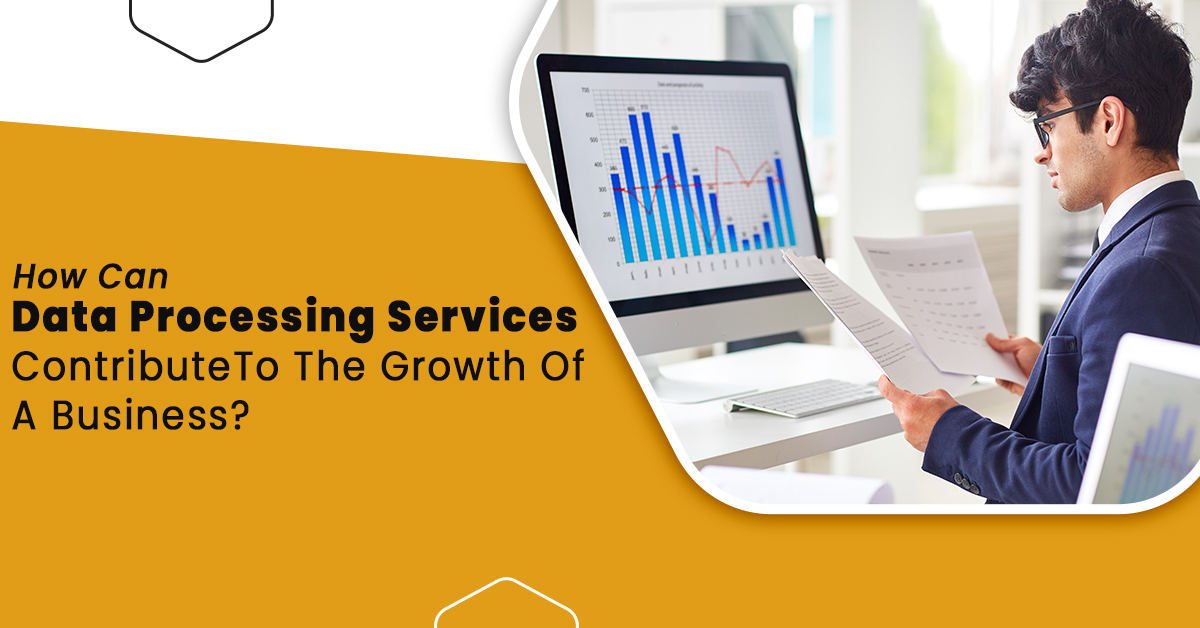How Data Processing Services Contribute To The Growth Of A Business?

What Is Data Processing?
Data processing is the process of gathering and transforming information into a useful and relevant format. Data manipulation is the automatic data processing in a predetermined series of processes. Nowadays, the processing is done automatically by computers, which is faster and produces more precise results.
Following that, the data is processed and then translated into a suitable form that can be used to conduct tasks according to the needs. The data comes from various places, including Excel files, databases, text files, and unstructured data like audio clips, photos, GPRS, and video clips. The output is then converted in various file forms, such as a chart, audio, table, graph, image, or vector file, using different software or applications.
In a nutshell, we can say that data processing is a way of gathering raw information and converting it into useful data.
Types Of Data Processing
There are numerous data processing techniques, depending on what the data is needed for. Let us discuss the five major types of data processing in detail.
Commercial Data Processing
Commercial data processing uses relational databases in a commercial setting, which involves batch processing. It entails feeding the system vast data and producing a significant output volume with fewer processing operations.
It essentially integrates commerce and computers to make it helpful for a company. Since the data processed by this system is usually standardized, there is a significantly smaller risk of errors.
Many manual tasks are automated using computers to make them easier and more error-free. Computers are employed to turn raw data into information beneficial to the company in the business world. Accounting programs are great examples of data processing applications.
Scientific Data Processing
Unlike commercial data processing, scientific data processing uses computing operations extensively while requiring fewer inputs and outputs. Arithmetic and comparison operations are among the computing operations.
Any chance of errors is unacceptable in this form of processing since it would lead to erroneous decisions. As a result, the process of validating, categorizing, and standardizing the data is carried out with great care, and a variety of scientific procedures are employed to ensure that no incorrect associations or conclusions are made.
This takes longer than data processing in a business setting. Processing, managing, and distributing science data products are common examples of scientific data processing, facilitating scientific analysis of algorithms, calibration data, and data products, and keeping all software, calibration data, and data products under strict configuration control.
Batch Processing
Batch processing is a sort of data processing that involves processing multiple cases simultaneously. It is most commonly utilized when the data is homogeneous and in big amounts, and it is collected and analyzed in batches. Batch processing is the concurrent, simultaneous, or sequential execution of an activity.
Simultaneous batch processing occurs when all of the cases are processed at the same time by the same resource. Sequential batch processing occurs when various cases are processed by the same resource either simultaneously or sequentially.
When they are processed by the same resources yet partially overlap in time, this is referred to as concurrent batch processing. It’s mostly employed in banking applications or places where higher degrees of security are necessary.
The computational time is reduced in this processing since the output is extracted by applying a function to the entire data set. It is capable of completing tasks with relatively little human assistance.
Online Processing
Online processing is the total opposite of batch processing. Like traditional query processing engines, online processing can be created from various relatively simple operators. Data processing via analytical internet activities usually includes enormous chunks of data from large databases.
As a result, it should come as no surprise that today’s online analytical tools offer interactive functionality. Precomputation is the key to their success. In most online data processing systems, the answer to each point and click is assessed long before the user even opens the application.
Real-Time Processing
The present data management system typically limits the capacity of processing data on an as-needed basis because it is always based on periodic batch updates, resulting in a time lag of many hours between an event occurring and it being recorded or updated.
This prompted a requirement for a system that would capture, update, and process the data on as and when basis, i.e., in real-time, which would help minimize the time lag between occurrence and processing to near nil. Huge amounts of data are being pumped into the systems of businesses; therefore, storing and analyzing it in real-time would be a game-changer.
Also Read:- Tax Planning: Definition, Benefits, And Pros Of Outsourcing Services
Stages Of Data Processing Cycle
The data processing cycle is made up of several steps in which raw data (input) is fed into a process (CPU) that generates actionable insights (output). Each step is performed in a specified order, although the procedure is repeated in a cyclic fashion. The output of the first data processing cycle can be saved and used as the input for the subsequent cycle.
Collection
It is the initial stage of the cycle, and it is quite important since the quality of the data obtained will have a significant impact on the output. The data acquired during the collecting phase must be defined and correct for subsequent decisions based on the findings to be valid. This stage establishes a baseline against which to measure progress and a goal for improvement.
Preparation
It is the process of transforming data into a format that may be used for additional analysis and processing. Data that has not been processed must be double-checked for accuracy. Preparation is the process of assembling a data set from one or more data sources for subsequent analysis and processing.
Analyzing data that hasn’t been thoroughly vetted for errors can yield highly deceptive conclusions that rely largely on the quality of the data used.
Input
It is the process of converting verified data into a machine-readable form so that an application can process it. A keyboard, scanner, or data entry from an existing source are all used to enter data.
This time-consuming operation necessitates accuracy and speed. Because a large amount of processing power is necessary to break down the complex data at this point, most data must follow a rigorous and rigid syntax. Many organizations are opting to outsource this stage due to the price.
Processing
It is performed when data is subjected to various complex technical manipulations, such as Machine Learning and Artificial Intelligence algorithms, to provide an output or interpretation.
Depending on the nature of the data, the process may be made up of many execution threads that execute instructions simultaneously. There are applications that can process massive amounts of heterogeneous data in a short amount of time.
Output
The step where processed data is now delivered and displayed to the user is known as output and interpretation. Users can see the output in a variety of report forms, including graphical reports, audio, video, and document viewers. The output must be analyzed to give useful information that will guide the company’s future decisions.
Storage
It’s the final stage of the data processing cycle, where data and metadata (data-related information) are stored for later use. This cycle is important because it provides quick access and retrieval of processed data, sending it directly to the next stage when needed.
Benefits Of Outsourcing Data Processing Services
Data processing work primarily involves reviewing the data and files that your company requires and transforming them into a usable and easy-to-access format consistent with your business procedures. Data processing experts know how to cross-analyze and correct the information they’ve been supplied.
This information is processed to make your resources work more efficiently. Outsourcing data processing services relieves you of the load of this time-consuming task and produces better outcomes than you could think.
Efficient Data Management
Your company’s success is fueled by a skilled provider gathering data from many sources and turning it into an understandable format. Due to their extensive experience in the sector, outsourced data processing service providers know what they’re doing and how to handle it properly.
Instead, if you choose to do it manually, you will need to go through various stages and pay professional workers to ensure that your data is properly utilized.
High-Quality Data
Thanks to the best data processing service providers, your data will be correctly structured and organized. You may rest assured that data loss will be minimal and that the data will be available for in-depth analysis to help the company grow. You risk losing data quickly if you don’t have the right tools and talent. Only a skilled data processing services company such as HRMB Associates LLC can effectively manage all information.
Cost-Effective
It is very expensive to hire an in-house data processing team with specialized capabilities to manage the task. For greater efficiency, you might quickly hand over the obligation to third-party data processing industry providers instead of going through the lengthy process. A successful company fully understands all of the complications of data methodology and can assist in halving costs.
Focuses On Core Competencies
Outsourcing data processing services allows you to concentrate on your company’s key competencies. It eliminates a slew of headaches while boosting operational revenues and corporate efficiency. Your newly hired employees won’t have to fumble around trying to find out how to use new technology, and employers won’t have to worry about expanding their office space.
Timely Deliveries
Data processing outsourcing services connect you with seasoned experts that deliver a comprehensive and rapid response. They give superior quality services rather than scrambling around like crazy chickens in the case of an emergency. A strong team can accomplish many complex things that an in-house team cannot with minimal expenditure.
Provides Competitive Advantage
Non-core services, like data processing, might be outsourced to allow you to focus on staying ahead of the competition. Instead of worrying about data entry, bookkeeping, and other processes, your company can make better decisions focused on growth with more time and effort.
If you want to increase your work productivity and focus on your company’s core competencies, outsource business data processing services to HRMB Associates LLC. We have been providing the finest accounting and financial services for several decades. We offer a wide range of services such as bookkeeping, data entry, HR consulting, tax preparation, and many more.


